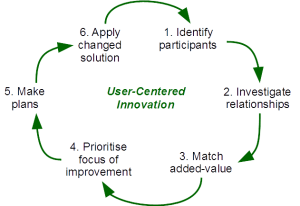The methodology of user-centered innovation combines three elements: A helicopter view, performance assessment and planning for improvements. All three are briefly described below.
Helicopter view. User-centered innovation provides a ‘helicopter’ view of the solution. In this view, the relationships among the participants are pivotal in determining the performance of the solution.
The six-step thought process to guide the implementation of user-centered innovation focuses first on the macro-level of the solution (steps 1, 2, 3 and 4) before addressing the local (‘micro’) level of the participants that are willing and able to make changes (steps 4 and 5).
The methodology is most effective when conducted jointly with representatives from each participant, this holds in particular for steps 2 to 4. The other steps can be conducted by each participant, ‘offline’ so to speak.
Performance assessment. The performance of the solution is dependent on the participants: the extent to which desired added-value is delivered. This manner of assessing performance does not make assumptions on what participants (should) want, rather each participant’s desired added-value is made explicit. This performance assessment avoids the pitfall that one participant ‘has all the advantages’ while the other participants experience a (much) lower performance. By focussing on the overall performance of the solution all participants are provided with an incentive to continue their participation (as their desired added-value is being fulfilled).
Joint plan for improvement. A solution can only be improved if one, or more, of the participants is able and willing to make changes. By making explicit the (dis)similarity between desired added-value and delivered added-value, it becomes possible to discuss improvements (if needed) in the relationship(s) between participants. This results in a joint plan for improvement, where each participant knows why an improvement is made and for whom. The process of improving thus becomes manageable and improvements can be tested.





